Edith Bons II
Edith Bons is an artist, born in Merauke Papua Indonesia (formerly Dutch New Guinea) in 1952. She completed her education at the ABK Minerva in Groningen. In August 2018 Edith exhibited some of her work on our website (see: https://indischmuseum.com/edith-bons/). In this update, Edith shows her new work and reflects on her development as an artist. Edith works with mixed techniques (2 and 3 dimensional) and produces installations.
Edith : «After not knowing what I wanted to do for a while, I decided at the age of 28, to take the plunge and enrol at an art academy; I wanted to become an autonomous artist. It were mainly friends who have encouraged me to do this. I was not a talker at that time and in this way I could express myself best about how I relate to my time and society. My parents weren’t much into art and culture; however my father did some drawing and designed and made furniture for our own use.

I first followed a teacher training in Groningen for two years (Drawing, Crafts and Textile work forms). But then I stopped. I didn’t see myself in front of a class of teenagers and I thought that an art academy was too ambitious for me. I ended up applying to several art schools. I was accepted everywhere but decided to stay in Groningen.
Because making a living as an artist was extremely difficult, I often had to explain to my friends and acquaintances why I chose the arts as destination. Art was in me. The fact that I passed all the selection rounds boosted my motivation. It was a very nice time, full of watching art and talking about it with friends.

Wandobject, Houten klompen, acryl, lakverf, plastic,
foto 39x27x19cm.
I graduated at a time when the BKR had just been abolished (Wikipedia: The Visual Artists Regulation (BKR) was a scheme in the Netherlands from 1956 to 1987, through which artists could receive an income in exchange for their services or works of art) and there was a dowry to help the new generation of artists on their way. There were many grants and I received some to get started. I filled the gaps I had in my education through courses, peer consultations and feedback from an art-loving audience.
What I missed during my training was a broader perspective. Art education was at that time only given from a Western point of view (especially when it came to aesthetics) and there was no room for an Eastern point of view. The use of decorative elements such as tessellation, for example, was a taboo within the idiom of contemporary art of the time, and really still is today. But also composition and perspective was substantially different in the East. The concept of ‘Interculturality’ was still emerging at the time (1980-1985). I encountered misunderstanding at the academy when I brought this up. That is why I decided to leave for Indonesia immediately after the art academy to fill that gap. Through a year and a half working there, exhibiting and discussing with my Indonesian colleagues, things were somewhat put right.

My aim has always been to create authentic work. And not to fall into some sort of mannerism. I always want to be challenged. My artworks should not fit into any category or movement. In terms of content I show as an artist many similarities with some (Dutch Indonesian) contemporaries. Because I work with various materials, my goal, from a technical point of view, is to process these materials in such a way that a new image is created while ignoring the meaning and function of the original material. This way of working is sustainable and responsible in this day and age.
Being Dutch Indonesian has had a lot of influence on my ideas, but less and less as I get older. This influence applies to the chosen materials as well as to the substantive themes. During the making process there is always an interaction of ideas, possibilities of the material and the moment itself.

GOLEK BAYI – Hout, acryl, plastic – 23x10x10CM (lxbxd)
KEPALA GOLEK – Hout, lakverf, ACRYL – 24X21X12 (lxbxd)
GOLEK PADY – Hout, acryl, ongepelde rijstkorrels, epoxy – 35X9X9 CM (lxbxd)
I will give two examples.
Recently I was busy to enlarge the Dutch-Indonesian influence; I didn’t want to limit myself to just that Dutch-Indonesian influence, but make my themes more universal. For example, I started with Dewi Sri, the rice goddess from the Javanese mythology. That is why I chose rice as a material, both in my installations and in my autonomous work. My autonomous work is unique, there is no other. This is in contrast to graphic work or images in bronze that are repeatable. Rice is also a universal symbol of fertility.
From this idea, I also allow symbols from other cultures in my work. The Western (read: Dutch) symbols are elaborated at this moment, because they are closest and most familiar to me. Especially ethnographic elements, which can be found in folk culture, determine my current visual language. We still have to see how this will develop.
Secondly, I appropriated the Poleng motif from Bali. To express the idea that we always balance between extremes and ultimately belong to nowhere and therefore should be authentic.


Je moet ingelogd zijn om een reactie te plaatsen.